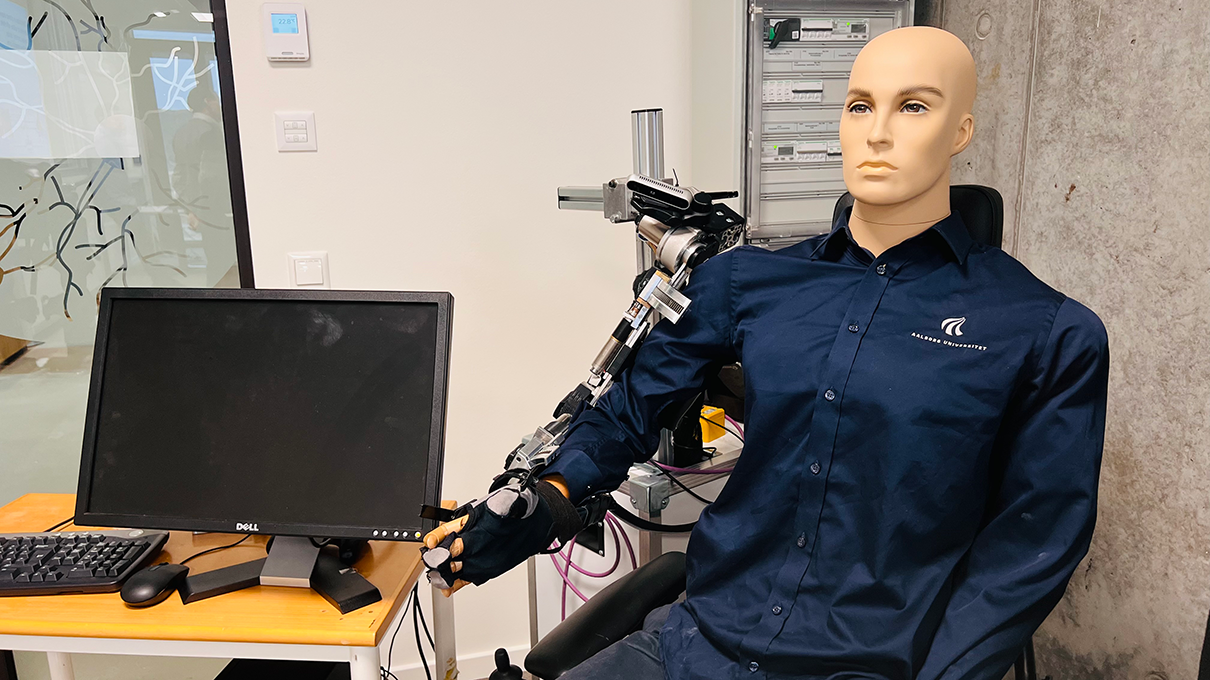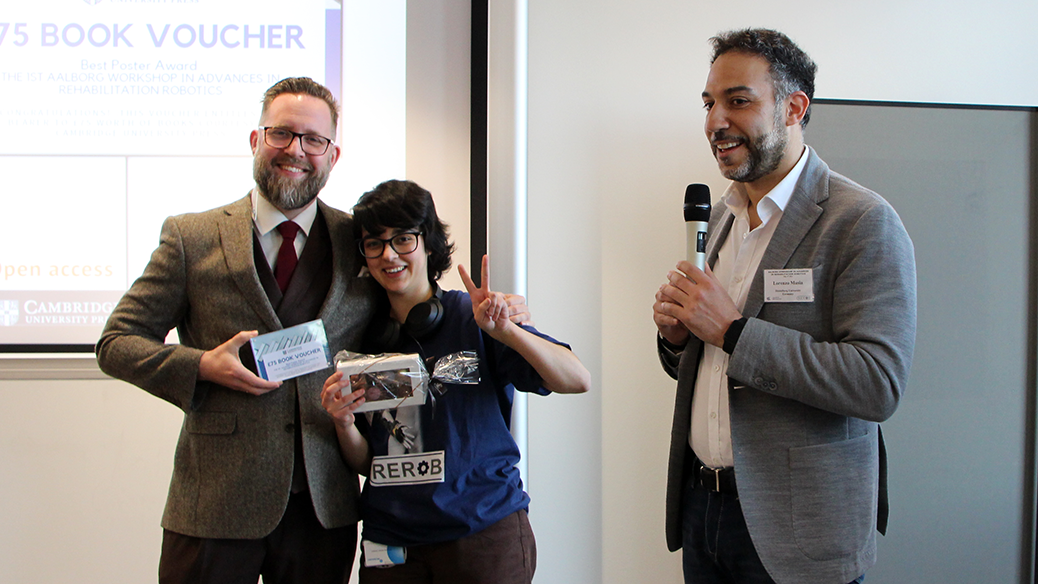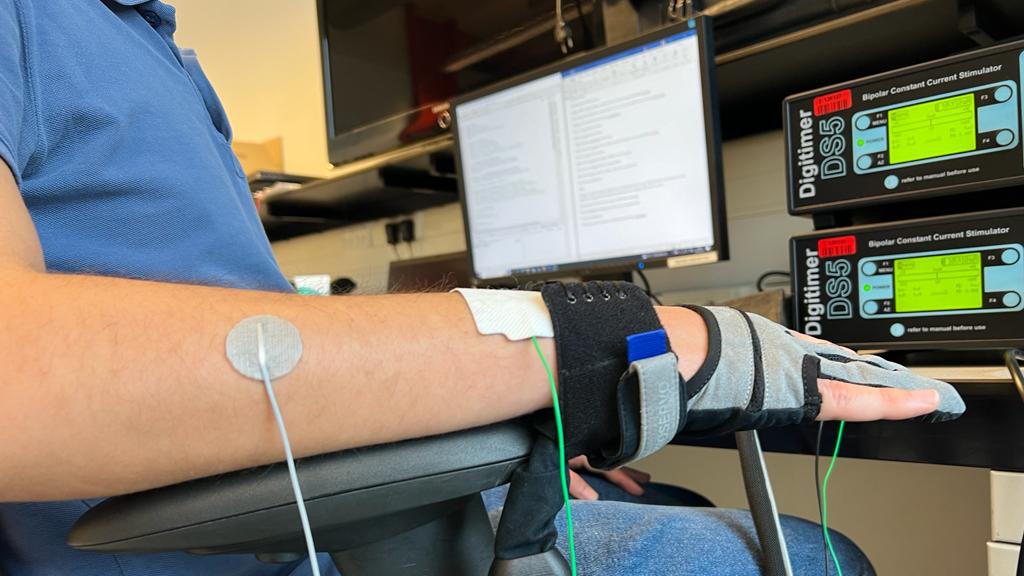Issue 4 - Thursday, 14th December 2023 |
|
|
|
(See bellow for the English version) |
NYHEDER |
|
 |
Man Kan Nu Styre EXOTIC2 Exoskelettet Med Hjerne, Tunge Og Muskelsignaler |
De sidste par måneder har budt på spændende nye udviklinger for CRERoB's kerneprojekt, EXOTIC2. Exoskelettet kan fungere med tre forskellige indputmodaliteter, såsom elektromyografi, tungebevægelser og elektroencefalografi. Det resulterende multimodale system kan derved skræddersys til omfanget af brugerens lammelse. EXOTIC2's multimodale kontrolsystem er sammensat af flere tæt forbundne hybridsystemer. Og fordi de er så tæt forbundne, kan erfaringen fra brugen af én inputmodalitet anvendes til de andre. Vi glæder os til snart at kunne analysere forsøgsresultaterne, først fra deltagere uden lammelser og nogle få brugere og derefter - i løbet af foråret 2024 - vil flere brugere få muligheden for at deltage.
|
|
CRERoB Modtager Støtte Til Metoder Til Als-Diagnose |
|
|
Forskere fra CRERoB har modtaget en bevilling på 3 mio. kr. fra Danmarks Frie Forskningsfond til et projekt om udvikling af en ny tungebaseret metode til diagnosticering af ALS. Det er målet, at denne metode vil reducere den aktuelle diagnosetid, der i gennemsnit er mere end 1 år, og derved muliggøre at sygdommen kan behandles tidligere for at bremse udviklingen. Bevillingen tildeles CRERoB-leder, Professor Lotte N. S. Andreasen Struijk i samarbejde med Klinisk Professor Jacob Blicher og Klinisk Lektor Izabella Obal. Yderligere vil der være samarbejde med Scott MacKenzie fra York University, Toronto, Canada. Læs mere her. |
|
|
Noninvasivt Tungeinterface |
 |
En ny noninvasiv version af tungeinterfacet er ed at blive tested. Den nye udgave har 15 induktive sensorer og et slankere, mere kompakt design. Den mest markante nyhed er imidlertid den integrerede aktiveringsenhed. I modsætning til den gamle version, som kræver en tungepiercing, har det nye noninvasiv tungeinterface en indbygget metallisk kugle, som er monteret i en ramme. Således kræve det nye tungeinterface ikke en tungepiercing. |
|
Ifølge Oguzhan Kirtas, ph.d.-studerende bag designet, var udviklingsprocessen udfordrende, men givende. En stor del af udfordringen var at reducere enhedens størrelse uden at gå på kompromis med signalkvaliteten.
”Vi prøvede at lave det [enheden] så lille som muligt. … Det var hovedformålet”, fortæller Oguzhan. ”Vi valgte afrundede, firkantede sensorer… for at minimere afstanden mellem sensorerne og forbedre signalkvaliteten”.
Aktiveringsenheden gennemgik også flere ændringer under udviklingen. Oguzhan påpeger, at der blev lagt stor vægt på at vælge aktiveringsenhedens størrelse, form og materiale, da disse faktorer i høj grad påvirkede enhedens brugervenlighed. På grund af den minimale invasivitet (ingen behov ofr tunge piercing) er det muligt at udvikle tungebaserede metoder til diagnosticering af oral motorisk dysfunktion baseret på systemet. |
|
|
CRERoB har fejret PhD forsvar indenfor ALS |
 |
Rasmus Leck Kæseler fra CRERoB forsvarede sin ph.d. afhandling: Tilpasning til progressiv lammelse: Et tunge-hjerne-hybrid robotinterface til personer med amyotrofisk lateral sklerose.
Rasmus' arbejde med hybride interfaces til ALS-patienter blev vejledt af professor Lotte N.S. Andreasen Struijk, og lektor Mads Jochumsen, og det har vist, hvor effektivt det er at kombinere tungekontrol med hjernebaseret kontrol og udnytte den tungefunktionalitet, før man skifter til rene hjernegrænseflader. Du kan læse mere her [x] og her [x]. |
|
Brugerne Giver Værdifulde Input Til CRERoB |
 |
Vi har haft brugerpanelssmøder med brugere med SCI og ALS, og det har givet meget værdifulde input, som er blevet integreret i vores systemer. Vi takker brugerne meget for indsatsen og tålmodigheden. |
|
|
ÅRET DER GIK |
 |
Overældende Tilslutining Til CRERoB Seminar 2023 |
I maj 2023 afholdte CRERoB ”The 1st Aalborg Symposium in Advances in Rehabilitation Robotics”, hvor programmet kan ses her. Der var overvældende stor tilslutning med mere end 80 deltagere og alle pladser var taget. Deltagerne talte brugere, brugerorganisationer, forskere, klinikere og virksomheder fra 8 forskellige lande. Oplægsholderne talte internationalt ledende eksperter fra bl.a. Imperial College, London, Heidelberg University, og Scuola superiore, Pisa, og klinkere fra Rigshospitalet og Neurorehab, Muskelsvindfonden og Robot virksomhederne Life Science Robotics og PTR robots samt forskere fra DTU og AAU. I demosessionen fremviste adskillelige nationale og internationale virksomheder og forskere deres robot-teknologer, herunder virksomhederne Rehab Mobility, TKS A/S, Assistive Innovations, Holland, LSR og, PTR Robots. Vi takker for den utroligt meget positive feedback vi har fået fra dagen. I kan finde mange af kommentarerne på vores LinkedIn side.
|
 |
Førende Internatiole Forskere Ved CRERoB PhD Kursus |
I forbindelse med CRERoB seminaret den 5. Maj 2023, afholdte CRERoB også et international PhD kursus, og også her var der stor national og international tilslutning. Oplægsholderne talte international ledende forsker, herunder Dario Farina fra Imperial Colleger, Lorenzo Masia fra Heidelberg University, Nicola Vitiello fra Scuola Superiore Sant’Anna, Italy. I forbindelse med PhD kruset var der en poster pitch konkurrence hvor tidsskriftet: Wearable Technologies, Cambridge University Press havde udlovet en præmie. Førstepladsen gik til PhD studerende Ana Sofia Cardoso fra CRERoB sammen med PhD studerende Benjamin Svejgaard fra Aalborg Universitetshospital og Klinisk Institut, Aalborg universitet. Senere vandt de igen en delt første plads ved en poster pitch konkurrence ved Aalborg Universitet – vi ønsker dem stort tillykke!
|
 |
CRERoB Hjælper Ved Førende International Konference |
CRERoB deltog med 4 artikler ved den store internationale konference i Sydney, hvor PhD studerende Ana Sofia Cardoso og Juwairiya Siraj Khan hjalp til med arrangementet. De 4 artikler fra CRERoB beskrev blandt andet usability af tunge interfacet – herunder at man kan tale med det. Dertil blev det nye noninvasive tungeinterface introduceret og vi beskrev en helt ny måder til at automatisere og simulere nogle af Eksoskeletbevægelserne. Læs mere her: artikel 1, artikel 2, artikel 3, artikel 4.
|
|
|
|
VORES PROJEKTER |
Følg os på LinkedIn og bliv opdateret. |
|
|
 |
Kerneprojekt EXOTIC Klæder Sig På - Brugeren Vælger Outfit |
EXOTIC2 |
CRERoB har indgået et samarbejde med AAU Designlab for at bringe EXOTIC til nye højder. Frederik Kiersgaard Lunds og Linda N. Laursens har arbejdet seriøst på at give EXOTIC exoskelettet en helt ny skal. Gennem hele designprocessen har Frederik integreret feedback fra både medlemmer af Rehab Mobility Neurorehabilitering og medlemmer af CRERoB's brugerpanel. Resultatet er en meget alsidig skal, der består af flere paneler, som kan tilpasses og skiftes ud, og fås i mange farver og mønstre.
Da brugerne blev spurgt om muligheden for at ændre skallen, havde de flere ønsker. Et medlem af CRERoB's brugerpanel sagde, at "der er en fordel i at kunne skifte det [skallen], hvis der for eksempel kommer ridser." Han tilføjede "[Det er] rart at kunne skifte, ligesom man skifter tøj. Alle andre skifter tøj.". Andre brugere ønskede også muligheden for at kunne vælge størrelsen på biceps. |
|
|
|
|
 |
EU Projekt Med ROBERT – Se Resultaterne |
ROBERT |
Vi har offentliggjort en artikel der viser hvordan vi bruger målte muskelsignaler til at starte elektrisk stimulation af svage muskler så man kan træne benene med rehabiliteringsrobotten ROBERT fra LSR. På den måde kan patienter med Apopleksi eller rygmarvsskade træne benene selvom de er ramt af lammelser. Læs mere her |
|
 |
Kliniske Forsøg Lige For Hånden |
HYPERHAND |
Der er travle uger i vente for HyperHand, mens gruppen forbereder sig på kliniske forsøg. De kommende undersøgelser vil fokusere på den kombinerede brug af en tungestyret tendon-driven exoskelet-handske og funktionel elektrisk stimulering. CRERoB har fået hjælp fra Vestdansk Center for Rygmarvsskade (VCR) og Hammel Neurocenter til kommende kliniske forsøg.
|
|
|
 |
Forsøg Med Rygmarvsskadede er Gennemført |
ITOOBOT |
Vi har udført test af tungestyring af robotarmen iARM med det nye non-invasive tungesstyringssystem hvor brugere med tetraplegi på grund af en rygmarvsskade har deltaget og vi er nu spændte i gang med at analysere resultaterne. Projektet er et samarbejde mellem CRERoB med TKS i Danmark og Assistive Innovations i Holland. |
|
|
|
VI ØNSKER JER ALLE EN GOD JUL OG ET GODT NYTÅR! |
|
|
|
|
|
 |
You can now control EXOTIC2 with your muscles, tongue and brain. |
The past few months have brought exciting new developments for CRERoB’s core project, EXOTIC2. The assistive upper-limb exoskeleton will soon support three different input modalities, including electromyography, tongue movements, and electroencephalography. The resultant multimodal system can then be tailored to the user’s degree of paralysis. EXOTIC2’s multimodal control system is composed of several closely linked hybrid systems. Moreover, because they are so closely related, knowledge gained from using one input modality can be applied to the others. We look forward to analyzing the trial results soon, first from participants without paralysis and a few users and then - during the spring of 2024 - more users will have the opportunity to participate.
|
CRERoB Receives Grant For Methods For ALS Diagnosis |
|
|
Researchers from CRERoB recieved a grant of 3 million DKK from the Independent Research Fund Denmark for a project on the developement of a new tongue based method for diagnosing ALS. The method will reduce the time for diagnosis - estimated more than 1 year - and allow for earlier treatment to slow down the disease's progression. The grant was awarded to CRERoB head, Professor Lotte N. S. Andreasen Struijk in collaboration with Clincal Professor Jacob Blicher and Clincal Associate Professor Izabella Obal. In addition, there will be collaboration with Scott MacKenzie from York University, Toronto, Canada. Read more about it. |
|
|
Non-invasive Tongue Interface |
 |
The new non-invasive version of the inductive tongue-computer interface is undergoing testing. The new mouthpiece has 15 inductive coils and a slimmer, more compact design. Its most notable feature, however, is its integrated activation unit. Unlike the previous version of the inductive tongue-computer interface, which requires a tongue piercing, the non-invasive version includes a built-in metallic sphere, which is suspended in a frame and do not require at tongue piercing. |
|
According to Oguzhan Kirtas, the Ph.D. fellow behind the design, the development process was challenging but rewarding. A big part of the challenge was reducing the size of the mouthpiece without compromising signal quality.
“We tried to make it [the mouthpiece] as small as possible. … It was the main aim”, said Oguzhan. “We ended up with rounded square-shaped coils … to minimize the space between the coils and improve the signal quality”.
The activation unit, too, underwent several changes during its development. Oguzhan points out that great consideration went into picking the size, shape, and material of the activation unit since these were factors that greatly impacted the device’s usability.
The lack of invasiveness (no need for a tongue piercing) opens possibilities for developing tongue-based methods for diagnosing oral motor disorders. |
|
|
CRERoB Has Celebrated a PhD Defense Within ALS |
 |
Rasmus Leck Kæseler from CRERoB defended his Ph.D. thesis: Adapting to progressive paralysis: A tongue-brain hybrid robot interface for individuals with amyotrophic lateral sclerosis.
Rasmus' work with hybrid interfaces for ALS patients was supervised by Professor Lotte N.S. Andreasen Struijk, and Associate Professor Mads Jochumsen, and it has shown how efficient it is to combine tongue control with brain control and utilize the remaining tongue functionality before switching to pure brain interfaces. Read more about his research here and here. |
|
Users Give Valuable Input to CRERoB |
 |
We have had user board meetings with users with SCI and ALS and this has given very valuable inputs that has been integrated to our systems. We greately thank the users for all the effeorts and patience |
|
|
LOOKING BACK ON 2023 |
 |
Overwhelming Support for CRERoB Seminar 2023 |
In May 2023, CRERoB held "The 1st Aalborg Symposium in Advances in Rehabilitation Robotics", where the program can be seen here. There was an overwhelming turnout with more than 80 participants and all seats were taken. The participants included users, user organisations, researchers, clinicians and companies from 8 different countries. The presenters were internationally leading experts from e.g. Imperial College, London, Heidelberg University, and Scuola superiore, Pisa, and clinicians from Rigshospitalet and Neurorehab, the Muskelsvindfonden and the Robot companies Life Science Robotics and PTR robots, as well as researchers from DTU and AAU. In the demo session, various national and international companies and researchers presented their robot technologies, including the companies Rehab Mobility, TKS A/S, Assistive Innovations (Netherlands), LSR and, PTR Robots. We thank you for the incredibly positive feedback we received from the day. You can find many of the comments on our LinkedIn.
|
 |
Leading International Researchers at CRERoB PhD Course |
In connection with the CRERoB seminar on 5 May 2023, CRERoB also held an international PhD course, and here too there was great national and international support. The presenters were international leading researchers, including Dario Farina from Imperial Colleges, Lorenzo Masia from Heidelberg University, Nicola Vitiello from Scuola Superiore Sant'Anna, Italy. In connection with the PhD course, there was a poster pitch competition where the journal Wearable Technologies, Cambridge University Press had offered a prize. First place went to PhD student Ana Sofia Cardoso from CRERoB together with PhD student Benjamin Svejgaard from Aalborg University Hospital and Clinical Institute, Aalborg University. Later they again won shared first place at a PhD poster pitch competition at Aalborg University – we wish them the best of luck!
|
 |
CRERoB Helps at Leading International Conference |
CRERoB participated with 4 articles at the major international conference in Sydney, where PhD students Ana Sofia Cardoso and Juwairiya Siraj Khan helped with the event. The 4 articles from CRERoB described, among other things, the usability of the tongue interface - including that you can talk while wearing it. In addition, the new noninvasive tongue interface was introduced and we described a completely new way to automate and simulate some of the exoskeleton movements. Read more here: article 1, article 2, article 3, article 4.
|
|
|
|
PROJECT HIGHLIGHTS |
Follow us on LinkedIn for regular updates on our projects. |
|
|
 |
Playing Dress-Up With EXOTIC – End-Users Pick The Outfit. |
EXOTIC2 |
CRERoB has partnered with the AAU Designlab to bring EXOTIC to new heights. Thanks to the earnest work of Frederik Kiersgaard Lund and Linda N. Laursen the EXOTIC upper-limb exoskeleton has a brand-new shell. Throughout the design process, Frederik integrated feedback from both users at Rehab Mobility Neurorehabilitering and members of CRERoB’s user board. The result is a highly versatile shell, composed of multiple panels, that can be customized and swapped out. When asked about the possibility of changing the shell, end-users reacted positively. A member of CRERoB’s user panel stated that “there’s an advantage to being able to change it [the shell] if, for example, scratches appear.” He added, “[It is] nice to be able to change [it] like you change clothes. Everyone else changes clothes.”. Other users would like to customize the size of the shell's biceps. |
|
|
|
|
 |
EU Project with ROBERT – See the Results |
ROBERT |
We have published an article showing how we use measured muscle signals to start electrical stimulation of weak muscles so that you can train your legs with the rehabilitation robot ROBERT from LSR. In this way, patients with apoplexy or spinal cord injury can exercise their legs even if they are affected by paralysis. Read more here |
|
 |
Clinical Trials at Hand |
HYPERHAND |
There are busy weeks ahead of HyperHand, as the team prepares for clinical trials. The coming experiments will investigate the combined use of a tongue-controlled tendon-driven exoskeleton glove and functional electrical stimulation. CRERoB has enlisted the help of The Spinal Cord Injury Centre of Western Denmark (VCR) and Hammel Neurocenter for the upcoming clinical trials.
|
|
|
 |
Tests With SCI Have Ended |
ITOOBOT |
We have carried out tests of tongue control of the robotic arm iARM with the new non-invasive tongue control system where users with tetraplegia due to a spinal cord injury have participated, and we are now excited to analyze the results. The project is a collaboration between CRERoB with TKS in Denmark and Assistive Innovations in the Netherlands. |
|
|
|
Check out our recent publications on the center's VBN page
|
|
|
|
WE WISH YOU ALL HAPPY HOLIDAYS AND A HAPPY NEW YEAR! |
|
|
|
Join our center networkReceive newsletters and information on seminars and other center activities. |
|
|
|
|